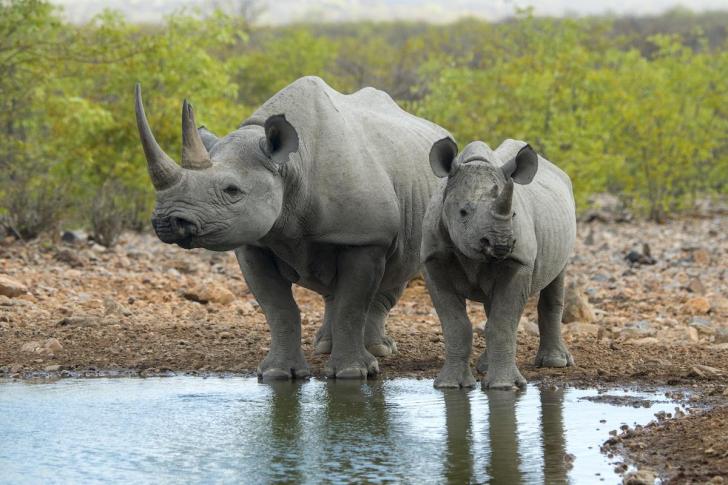News / National
29 white rhinos return to Zimbabwe park after 100 years
4 hrs ago | Views

For the first time in nearly 100 years, 29 white rhinos are once again roaming freely across the wild expanse of Gonarezhou National Park, marking a historic milestone in Zimbabwe's conservation history.
This landmark reintroduction, carried out between April and May 2025, is the result of years of meticulous planning by the Gonarezhou Conservation Trust (GCT)-a collaborative initiative between the Zimbabwe Parks and Wildlife Management Authority (ZimParks) and the Frankfurt Zoological Society, supported by the Government of Zimbabwe, Malilangwe Trust, and other donor partners.
The goal is to re-establish a viable, free-ranging population of white rhinos in Zimbabwe's second-largest national park, restoring a species that has been absent from the region since the early 1900s. While sporadic sightings of lone white rhinos occurred as recently as 1992, Gonarezhou has lacked a sustainable population for over a century.
Although Zimbabwe began reintroducing white rhinos in the latter half of the 20th century, especially from KwaZulu-Natal, South Africa, previous efforts had not targeted Gonarezhou-until now.
Planning for this operation began in 2023, building on the experience of the successful black rhino reintroduction in 2021. This latest operation involved a series of critical steps: habitat suitability studies, identification of source populations, community engagement, transport logistics, and post-release monitoring strategies.
The Malilangwe Trust, a longtime conservation partner in the Lowveld, donated the founding rhinos and provided crucial scientific, logistical, and technical support. The selected rhinos were chosen based on age, sex, and social structure to ensure strong chances of acclimating and forming cohesive groups in their new environment.
The rhinos were initially housed in temporary enclosures before being released into the wider park, where they are now under close observation by ground teams, veterinarians, and conservation scientists. Their movements, health, and adaptation are being meticulously tracked to ensure their successful integration.
Independent experts, including wildlife veterinarians, trackers, helicopter pilots, and rhino handlers, were integral to the operation's success, demonstrating the high level of collaboration that has defined this effort.
"This reintroduction is more than just the return of a species-it is a powerful symbol of what is possible when partnerships, science, and commitment come together," said a spokesperson for the Gonarezhou Conservation Trust.
While the return of the white rhino to Gonarezhou is a landmark achievement, stakeholders caution that the journey has just begun. The rhinos will require long-term protection, rigorous monitoring, and robust anti-poaching efforts to secure their future.
The GCT emphasized that the success of this reintroduction will depend on sustained collaboration among conservation agencies, local communities, and international donors. Their motto-"A Conservation Partnership"-remains central to the mission.
Gonarezhou is now living up to its legacy as a sanctuary for endangered giants-elephants and rhinos alike.
This landmark reintroduction, carried out between April and May 2025, is the result of years of meticulous planning by the Gonarezhou Conservation Trust (GCT)-a collaborative initiative between the Zimbabwe Parks and Wildlife Management Authority (ZimParks) and the Frankfurt Zoological Society, supported by the Government of Zimbabwe, Malilangwe Trust, and other donor partners.
The goal is to re-establish a viable, free-ranging population of white rhinos in Zimbabwe's second-largest national park, restoring a species that has been absent from the region since the early 1900s. While sporadic sightings of lone white rhinos occurred as recently as 1992, Gonarezhou has lacked a sustainable population for over a century.
Although Zimbabwe began reintroducing white rhinos in the latter half of the 20th century, especially from KwaZulu-Natal, South Africa, previous efforts had not targeted Gonarezhou-until now.
Planning for this operation began in 2023, building on the experience of the successful black rhino reintroduction in 2021. This latest operation involved a series of critical steps: habitat suitability studies, identification of source populations, community engagement, transport logistics, and post-release monitoring strategies.
The Malilangwe Trust, a longtime conservation partner in the Lowveld, donated the founding rhinos and provided crucial scientific, logistical, and technical support. The selected rhinos were chosen based on age, sex, and social structure to ensure strong chances of acclimating and forming cohesive groups in their new environment.
The rhinos were initially housed in temporary enclosures before being released into the wider park, where they are now under close observation by ground teams, veterinarians, and conservation scientists. Their movements, health, and adaptation are being meticulously tracked to ensure their successful integration.
Independent experts, including wildlife veterinarians, trackers, helicopter pilots, and rhino handlers, were integral to the operation's success, demonstrating the high level of collaboration that has defined this effort.
"This reintroduction is more than just the return of a species-it is a powerful symbol of what is possible when partnerships, science, and commitment come together," said a spokesperson for the Gonarezhou Conservation Trust.
While the return of the white rhino to Gonarezhou is a landmark achievement, stakeholders caution that the journey has just begun. The rhinos will require long-term protection, rigorous monitoring, and robust anti-poaching efforts to secure their future.
The GCT emphasized that the success of this reintroduction will depend on sustained collaboration among conservation agencies, local communities, and international donors. Their motto-"A Conservation Partnership"-remains central to the mission.
Gonarezhou is now living up to its legacy as a sanctuary for endangered giants-elephants and rhinos alike.
Source - Mirror


































